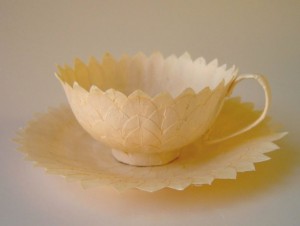The Woman With The Paper Teacups
Cecilia Levy has a commanding presence. Even over Skype — the only method for our interview seeing as Levy’s in Sweden and I’m in Cleveland, Ohio — her voice is clear and strong. Even when she struggles to find the right word in English, one can’t ignore her presence. In that way, Cecilia is much like the art she creates. Her intricate paper mache teacups and bowls made from recycled book pages look so fragile sitting by themselves, but they also command attention, in an unassuming way.
Elisabet Berg, graphic designer, illustrator and founding member of Kaleido — a cooperative gallery and shop in Sweden — still remembers the “paper things” Levy exhibited in her first show there.
“The exhibition was a kind of rest or meditation for me — a recovery from the restless and stressful age we live in,” Berg wrote in an email. “Here was someone who had worked meticulously over a long time and created objects that didn’t scream for attention.”
Levy’s background is in graphic design and bookbinding, and paper has been her medium of choice since childhood, when she used it for drawing and practicing calligraphy. She said, she’s always “wanted to work more freely as an artist,” but it wasn’t until 2009 that she began to explore that idea further.
When Berg asked her to exhibit her work at Kaleido, Levy knew she couldn’t display her usual “two-dimensional things” because it was an arts and crafts gallery.
“In Sweden we have a saying like lightning from a clear blue sky,” Levy said. “I thought, ‘I’ll try to do something with paper three-dimensionally.’ I got an inkling and thought, ‘Oh I might try book pages.’”
The idea may have come to Levy suddenly, but the process to make these intricate teacups and bowls took a little longer to master. At first she used porcelain teacups and applied the paper mache directly to them. When it dried though, it became impossible to peel the paper off, ruining the whole piece. She instead made silicone molds of the cups and bowls and applied the paper mache inside the molds.
When it came time for her show at Kaleido in September 2010, Levy had not only developed her process, but she had created beautiful pieces that represented a new outlet for the trained graphic designer and some new blood for the arts and crafts movement.
“Her show was stripped-down, elegant, graceful and a nice surprise,” Berg said. “We all immediately fell in love with her works.”
Many people have fallen in love with Levy’s work, including the National Museum in Stockholm which will display some of her pieces in the Slow Art exhibition this summer and Dagens Nyheter, the Swedish newspaper that featured a photo of one of Levy’s pieces under the headline “Paper is popular.”
Still, as Levy explains, there are plenty of people who don’t quite understand her art.
“There’s an interest, but people still don’t understand what it is. They ask me if they can drink out of them,” she said. “People want to define this, and I can’t define it. For me it’s just art. It’s not meant to be anything other than a beautiful object.”
Although Levy has a graphic design background and still does design work, she sees her move toward bookbinding and paper mache as a reaction to the technical direction graphic design was going.
“When I started my education, we did a lot of things by hand, but that disappeared,” she said, referring to the field’s move to computers.
She worked in graphic design for a few years after she finished school, but she still had a desire to work with her hands, and therefore, began learning the art of bookbinding. She took a weeklong course in book binding years ago, and then, five years later, attended a school for bookbinding. Not long after, she began teaching bookbinding to art and design students at The School of Design and Crafts at the University of Gothenburg.
Levy prefers to be in “fine arts mode” rather than “graphic design mode,” and now couldn’t be a better time. “Paper is coming on strongly,” she said. “I feel like with the economic times there’s an interest to go back to nature. I’ve realized that there are a lot of people out there working as paper artists. Maybe not in the same way I am, but I’m not alone.”
“I think we have a need to go back to basics,” Levy added. “I think you can see it in other materials as well. Not only paper but also wood and textiles. Just look at all the arts and crafts. A lot of things are happening with all the do-it-yourself scenes. I think as a balance, we need this.”
Maybe it’s a backlash against the more is more mentality that prevailed before the recession. Maybe it’s because of all those D.I.Y. scenes popping up everywhere. Or, maybe, people are learning to appreciate simplicity again. Whatever it is, paper is indeed popular.


